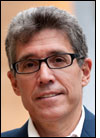Apr 01, 2012In compiling this special issue marking RFID Journal's 10th anniversary, we tried to refrain from patting ourselves on the back. This milestone is significant for us, but our focus has always been on our readers, on helping you figure out how to use this powerful technology to better manage your business. With this look back, we wanted to put RFID in perspective, giving you the opportunity to see where RFID has come from so you can see where it is going.
We invited some of the people who built the industry to contribute personal essays, in which they reflect on "growing pains," "unforeseen possibilities" and the behind-the-scenes efforts to advance a new technology (see Reflections From RFID Leaders). Two of our guest essayists are the cofounders of the Auto-ID Center. Sanjay Sarma is the brilliant MIT professor who, along with his colleague David Brock, jump-started the industry by dreaming up the idea of a low-cost RFID tag that could be associated with a wealth of material in online databases. This concept became the basis for the Electronic Product Code. Kevin Ashton worked tirelessly to build the Auto-ID Center into a research organization capable of delivering on their ideas.
Ashton also is credited for coining the phrase "Internet of Things," a network that, as you'll see in our feature story, "promises to connect everything and everyone everywhere to everything and everyone else" (see The Internet of Things). Motorola CTO Paul Steinberg sums it up this way: "One analysis put forth the estimate that [the IoT will include] connectivity among 50 to 100 trillion different objects, with each human being surrounded by 1,000 to 5,000 distinct objects. RFID, which imposes a cost of only pennies per tag, enables the cost-effective connection of such a large number of objects."
Other guest essayists, including Airbus' Carlo Nizam and the U.S. Department of Defense's Paul Peters, are from companies or organizations that were early adopters of RFID, and from RFID providers that championed the technology early on. You can find out more about some of their organizations' contributions on our timeline of key RFID events that occurred during the past 12 years (see Milestones in Radio Frequency Identification).
This issue also features an interview I conducted with Geoffrey Moore, author of Crossing the Chasm, Inside the Tornado and other seminal books that focus on technology adoption. Moore provides insights into the pace of RFID adoption and charts a course for the road ahead (see The Key to RFID Adoption).
Clearly, RFID Journal's history is intimately entwined with the RFID industry, so I believe it's enlightening to tell our story—how we went from a simple Web site published out of a spare bedroom to a global media and events company (see The RFID Journal Story). Today, all our guest essayists and I share a common belief: RFID has matured, its benefits have been proved and it will have a significant positive impact on the way companies do business.
I thank all of you for your support over the past 10 years. Without you, there would be no RFID Journal—and no RFID industry.


